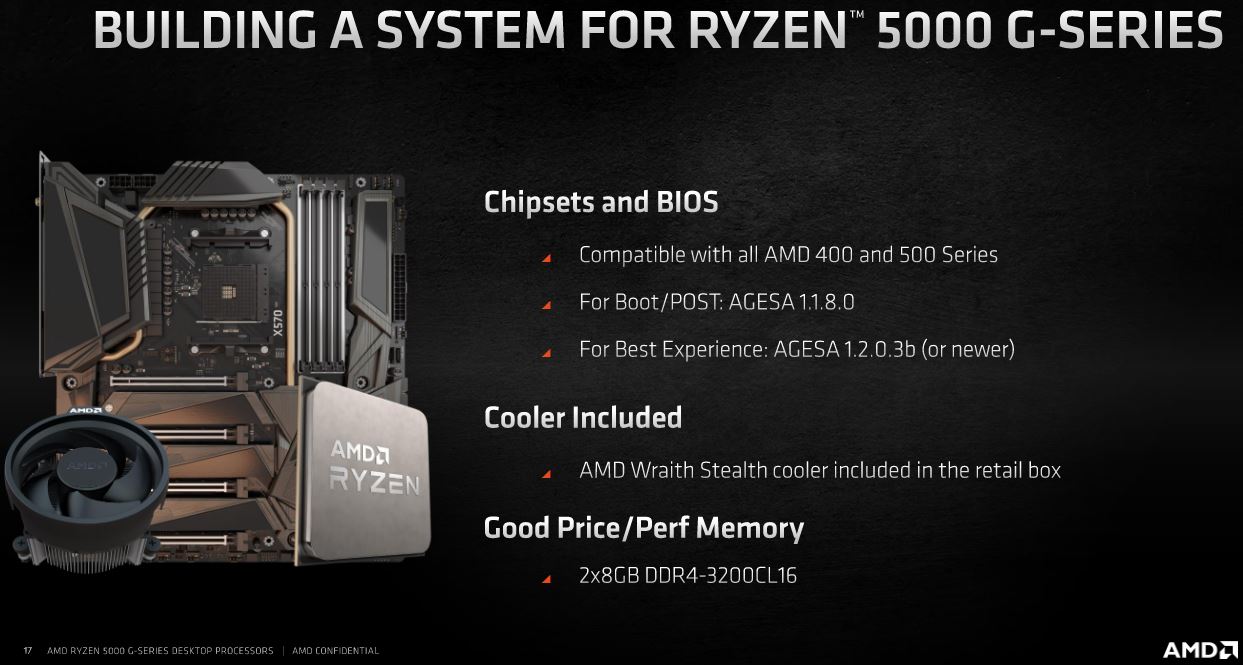Tom's Hardware Verdict
If AMD brings it to retail, the Ryzen 3 5300G will be the best budget CPU on the market. Unfortunately, it's confined to OEM systems for now.
Pros
- +
+ Faster Zen 3 CPU cores
- +
+ Solid 720p gaming
- +
+ Excellent power consumption and efficiency
- +
+ Great overclocking headroom
- +
+ Compatible with some AM4 motherboards
Cons
- -
OEM systems only
- -
Restricted 1080p gaming
- -
PCIe 3.0 connectivity
Why you can trust Tom's Hardware
Today we're testing what would undoubtedly be one of the best chips on the retail market. If only it were available on store shelves, AMD's as-yet unreleased-to-retail Ryzen 3 5300G would surely be the best value chip that money could buy. In fact, with four Zen 3 CPU cores and eight threads paired with the surprisingly still-powerful Vega 6 graphics engine, this chip could revitalize the value chip segment if priced in the $130 to $150 range. However, for now, this Cezzane chip and its surprisingly potent integrated graphics remain confined to often-crippled OEM systems — AMD hasn't brought it to retail yet. But as we've seen with the 5300Gs' more powerful counterparts, AMD could choose to open these up to DIYers, upsetting our CPU Benchmark Hierarchy and setting up a pitched battle for supremacy on both our Best CPUs for gaming and Best Cheap CPUs rankings.
AMD's first salvo of 7nm 'Cezanne' APUs for desktop PCs proved to be exceptionally attractive during these soul-crushing times of the GPU shortage. Those chips come bristling with the most potent integrated graphics you can get in an x86 desktop chip, and remarkably, they've remained in stock at suggested pricing since launch — a rarity in this silicon-starved world. Provided that you align your expectations accordingly, both the $359 Ryzen 7 5700G and $259 Ryzen 5 5600G serve up impressive iGPU gaming performance, showing that the Zen 3 architecture paired with Vega graphics can still outclass the best integrated graphics that Intel has to offer.
AMD's Ryzen 5000G chips mark a huge step forward, but the company's decision to keep the Ryzen 3 5300G off of store shelves is disappointing. That's probably because the chip is too good for its own good, though.
Assuming that AMD would price the 5300G at $150, it would retail for 60% less than $359 5700G and 40% less than the $259 5600G. However, according to our testing, the Ryzen 3 5300G delivers 86% of the gaming performance of the 5700G and 90% of the 5600G at 1280x720. That's a great value if we focus specifically on integrated graphics performance, which is really the only reason to consider buying this chip. However, it's clear that this could siphon away AMD's sales of pricier alternatives.
| CPU | Arch. | Price | Cores/ Threads | Base/ Boost Freq. | GPU Cores | GPU Freq. (MHz) | TDP | L3 (MB) |
| Ryzen 7 5700G | Zen 3 | $359 | 8 / 16 | 3.8 / 4.6 | RX Vega 8 | 2000 | 65W | 16 |
| Ryzen 5 5600G | Zen 3 | $259 | 6 / 12 | 3.9 / 4.4 | RX Vega 7 | 1900 | 65W | 16 |
| Ryzen 3 5300G | Zen 3 | N/A (possibly ~$150) | 4 / 8 | 4.0 / 4.2 | RX Vega 6 | 1700 | 65W | 8 |
That wouldn't make good business sense for AMD because it certainly doesn't have any issues selling its Ryzen chips at a premium. Besides, before the Ryzen 5000G chips came to market, AMD had already put its APU lineup on the backburner for a few years — the Cezanne chips arrived three chip generations (Zen 2, XT, Zen 3) after AMD launched its last round of 12nm quad-core Zen+ APUs for the DIY market in 2019 — so in many ways, this is more of the same.
AMD still hasn't brought any Zen 3-powered Ryzen 3 chip to retail yet, or the three 35W GE-Series APUs that would also be great lower-priced chips.
AMD has used the 5000G series to plug pricing gaps in its Ryzen 5000 lineup, the company insists they serve as replacements for the traditional non-X equivalents (we disagree), and the Ryzen 5 5600G lowered the steep $299 price of entry to Ryzen 5000 down to $259.
That's still plenty expensive for the cheapest Zen 3 chip, so a $150 Ryzen 3 5300G, conceivably with a bundled cooler, would be a boon for enthusiasts, especially for extreme budget gaming rigs while we wait out the GPU shortage, or small form factor and HTPC rigs.
Our list of Best Cheap CPUs could certainly use an update, too: There simply hasn't been any significant releases of cheaper CPUs in the recent past, and most of our top picks sell well above standard pricing or simply aren't available. Given that cryptocurrency mining has risen in popularity again, we don't expect GPU pricing to normalize any time soon, either. All of which would make the Ryzen 3 5300G an almost perfect solution for value seekers, especially given its great performance in our integrated graphics test suite.
The Overall Benchmark TLDR:
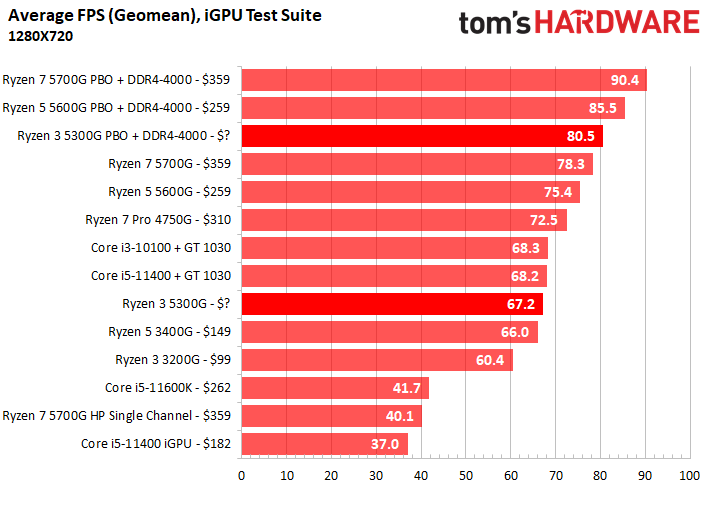

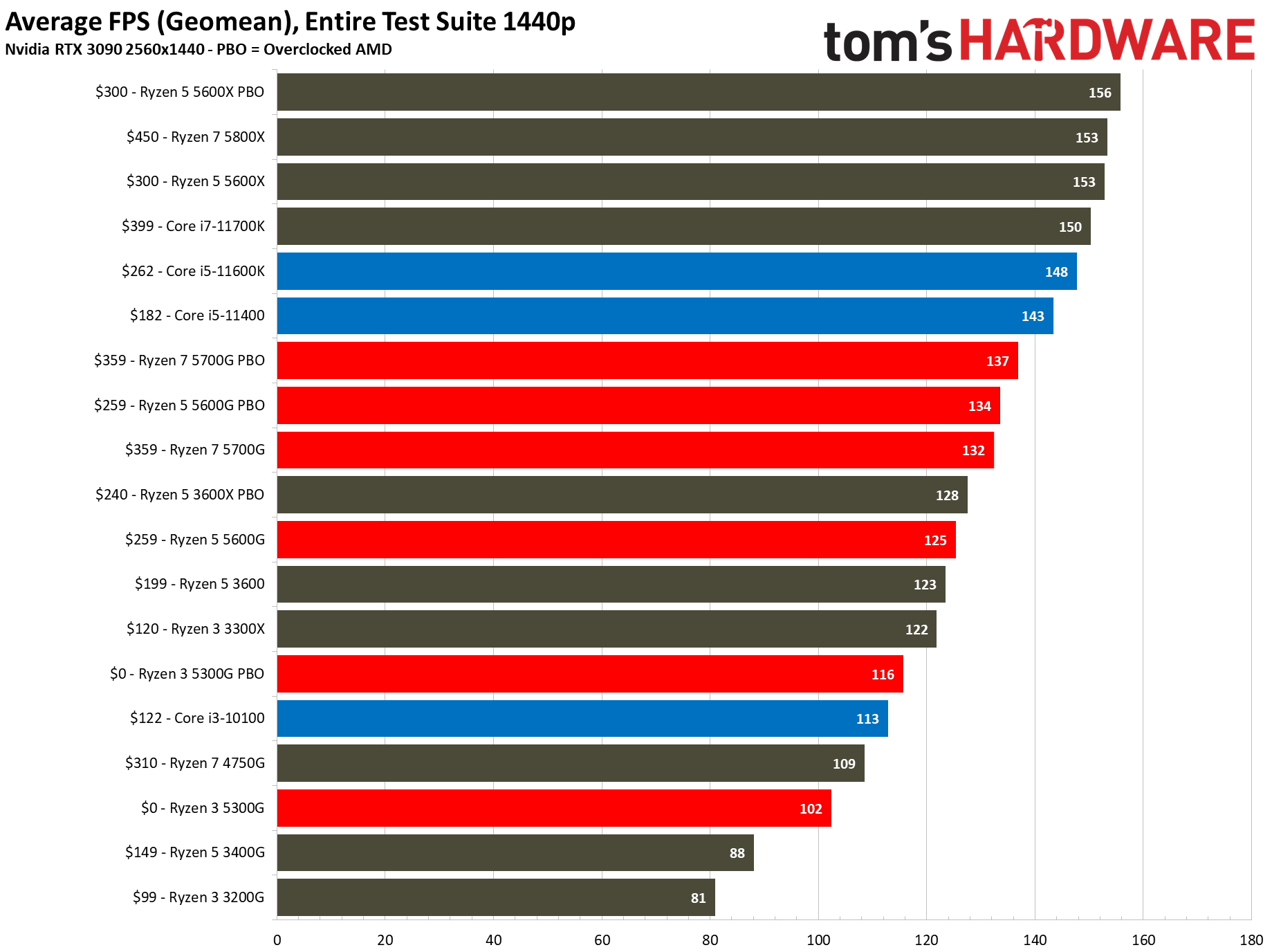

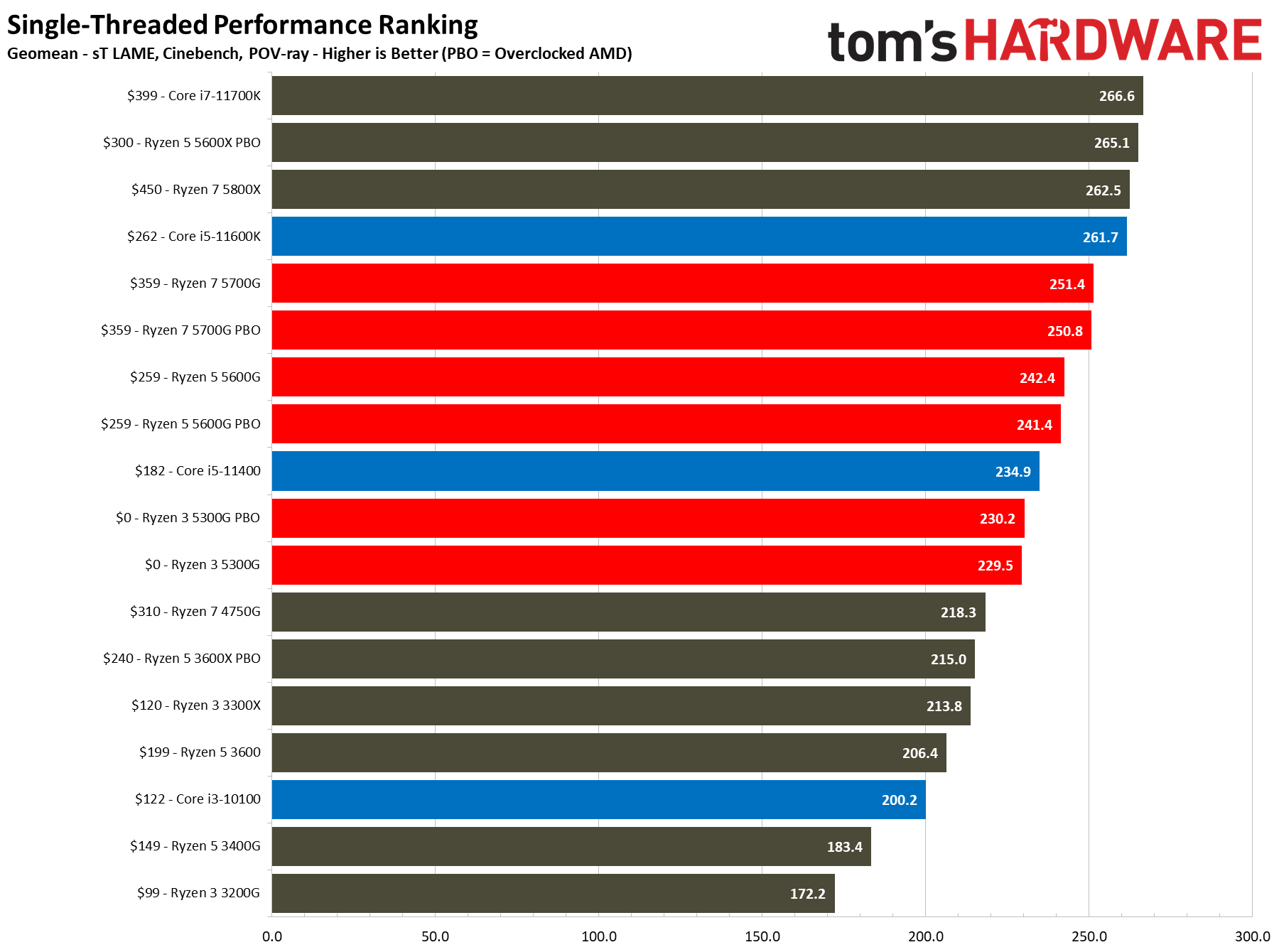
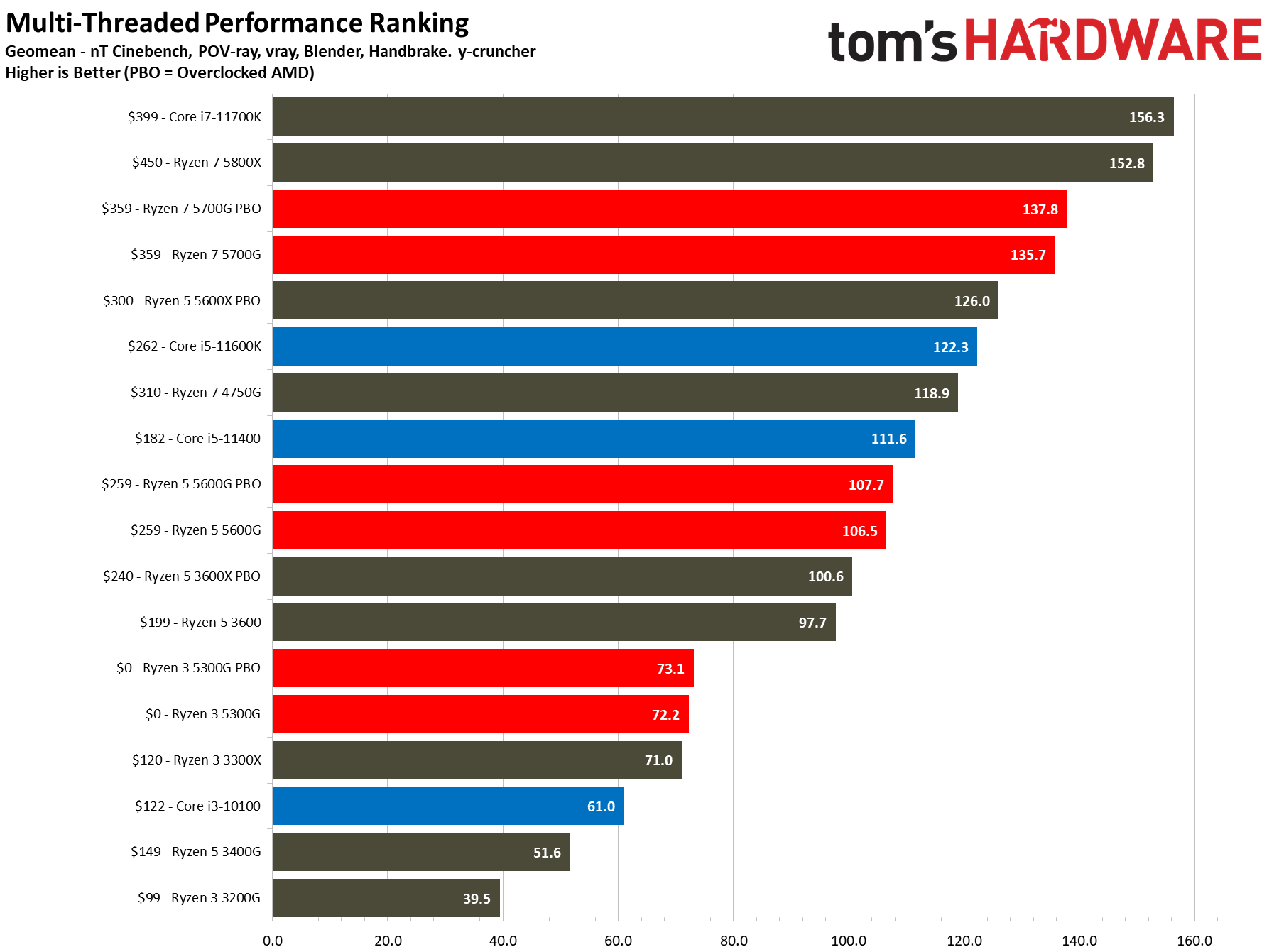
We'll go over the various benchmarks behind these cumulative results in great depth on the following pages, but these slide provide a quick summation of our test results. The first two slides show gaming performance with the integrated GPU and the second two slides show performance when you pair the chips with a discrete GPU. The final two slides show performance in both single- and multi-threaded applications. Be sure to hit the following pages for a more in-depth look at the results, and the final page for our overall analysis.
AMD Ryzen 3 5300G Specifications and Pricing
The Ryzen 5000G 'Cezanne' family spans from four to eight cores and has the Zen 3 architecture that provides a 19% IPC uplift over the Zen 2 architecture used in the previous-gen Ryzen 4000G models (those chips never came to retail, though). We've covered Cezanne's architectural details here.
| CPU | Arch. | Price | Cores/ Threads | Base/ Boost Freq. | TDP | L3 (MB) | GPU Cores | GPU Freq. (MHz) |
| Ryzen 7 5800X | Zen 3 | $449 | 8 / 16 | 3.8 / 4.7 GHz | 105W | 32 (1x32) | N/A | N/A |
| Core i7-11700K (KF) | Rocket Lake | $374 - $349 | 8 / 16 | 3.6 / 5.0 | 125W | 16 | UHD Graphics 750 Xe 32EU | 1300 |
| Ryzen 7 5700G | Zen 3 | $359 | 8 / 16 | 3.8 / 4.6 | 65W | 16 | RX Vega 8 | 2000 |
| Ryzen 7 4750G | Zen 2 | ~$310 | 8 / 16 | 3.6 / 4.4 | 65W | 8 | RX Vega 8 | 2100 |
| Ryzen 5 5600X | Zen 3 | $299 | 6 / 12 | 3.7 / 4.6 GHz | 65W | 32 (1x32) | N/A | N/A |
| Core i5-11600K (KF) | Rocket Lake | $262 (K) - $237(KF) | 6 / 12 | 3.9 / 4.9 | 125W | 12 | UHD Graphics 750 Xe 32EU | 1300 |
| Ryzen 5 5600G | Zen 3 | $259 | 6 / 12 | 3.9 / 4.4 | 65W | 16 | RX Vega 7 | 1900 |
| Ryzen 5 3600 | Zen 2 | $200 | 6 / 12 | 3.6 / 4.2 | 65W | 32 | N/A | N/a |
| Core i5-11400 (F) | Rocket Lake | $182 - $157 | 6 / 12 | 2.6 / 4.2 | 65W | 12 | UHD Graphics 750 Xe 24EU | 1300 |
| Ryzen 3 5300G | Zen 3 | N/A | 4 / 8 | 4.0 / 4.2 | 65W | 8 | RX Vega 6 | 1700 |
| Ryzen 5 3400G | Zen+ | $149 | 4 / 8 | 3.7 / 4.2 | 65W | 4 | RX Vega 11 | 1400 |
| Ryzen 3 3200G | Zen+ | $99 | 4 / 4 | 3.6 / 4.0 | 65W | 4 | RX Vega 8 | 1250 |
If we go strictly by product naming, the Ryzen 3 5300G replaces the aged $99 Ryzen 3 3200G. However, its four cores are threaded, whereas the 3200G only had four threads, so the 5300G feels more like the old Ryzen 5 3400G that came with the same number of CPU cores.
The Ryzen 3 5300G comes with four CPU cores and eight threads running at a 4.0 GHz base and 4.2 GHz boost clock. It also comes with 8MB of L3 cache, but it's more generously-equipped Ryzen 5000G counterparts come with 16MB. As you'll soon see, that has a big impact on gaming performance when you pair the 5300G with a discrete GPU, so it doesn't really slot into the role of a stop-gap replacement that you would continue to use if you plan to buy a discrete GPU in the future when pricing returns to some form of normal.
The $259 Ryzen 5 5600G plugged the $100 gap between the $299 Ryzen 5 5600X and AMD's entire sub-$299 product stack. For now, the previous-gen $200 Ryzen 5 3600 represents the next step down AMD's product stack. Given the performance we've seen from the Ryzen 3 5300G, we think that AMD would price the chip from $130 to $150, with the latter being more likely due to Intel's lack of a competing chip with robust integrated graphics in this segment.
Speaking of Intel, it doesn't have any Rocket Lake Core i3 processors. Instead, it relies on the refreshed 10th-Gen Comet Lake models to firm up its low end lineup. As a result, Intel's 10th-Gen Core i3-10325 would be the only competing chip, but it still comes with the entirely inadequate UHD Graphics 630 engine that doesn't put the chip in the same class as the Ryzen 3 5300G.
Get Tom's Hardware's best news and in-depth reviews, straight to your inbox.
AMD chose to reuse the 7nm Vega graphics engine instead of incorporating newer RDNA variants. The Ryzen 3 5300G comes with the Vega 6 graphics engine with six CUs running at 1.7 GHz. That's one fewer CU and a 200 MHz reduction from the Ryzen 5 5600G, which results in a larger iGPU performance delta between the two chips that we've measured with the other Ryzen 5000G models. The chip has a configurable TDP (cTDP) that stretches from 45W to 65W, though most desktop PCs will operate at the latter threshold.
As with all Zen 3 processors, the Ryzen 5000G chips step up from DDR4-2933 to the DDR4-3200 interface, which will help boost gaming performance with the integrated GPU. Surprisingly, the majority of the Ryzen 5000G 'Cezanne' SoC comes from the Ryzen 4000 'Renoir' SoC. To improve time to market, AMD essentially swapped in new Zen 3 cores, leaving the I/O, 7nm Radeon RX Vega integrated graphics engine, and SoC design intact. As such, the 5600G has 24 lanes of PCIe 3.0 connectivity compared to 24 lanes of PCIe 4.0 found on the Ryzen 5000 models for the desktop PC.
The Cezanne desktop chips drop into 500-series and some 400-series motherboards, though support on the latter will vary by vendor.
MORE: Best CPUs for Gaming
MORE: CPU Benchmarks Hierarchy
MORE: AMD vs Intel
MORE: All CPUs Content
Current page: Revitalizing the Low End
Next Page AMD Ryzen 3 5300G Power, Thermals, Setup and Overclocking
Paul Alcorn is the Editor-in-Chief for Tom's Hardware US. He also writes news and reviews on CPUs, storage, and enterprise hardware.
-
escksu Replyhotaru251 said:i do question how pci 3.0 is a con on a cpu that is focused on being budget option.
ITs a con because all Ryzen APUs are PCIE-3.0, this means 5600G, 5700G all PCI-E3.0.....
The APU was supposdly to be a great product but AMD "castrated" it by literally halving the cache and using PCIE 3.0. On top of that, they use back Vega instead of RDNA....
Now, imagine what the APU would be like if AMD had taken a different approach. The use the same Zen3 with PCIE and full cache and drop in RDNA GPU. It would been a monster. I am find if they sell it more than the non-APU verison. -
Krotow Replyescksu said:Now, imagine what the APU would be like if AMD had taken a different approach. The use the same Zen3 with PCIE and full cache and drop in RDNA GPU. It would been a monster. I am find if they sell it more than the non-APU verison.
Apparently this will appear, but for double price :p -
Gillerer Since TSMC's N7 process is supposed to have great yields, AMD probably doesn't have many APU dies with 3+ faulty cores or 2 faulty CUs to go around.Reply
That means the only reason this 4-core alternative exists is to use up the few failed dies to satisfy their partners' greed; allowing OEMs to produce low-cost systems they can overcharge for.
AMD have stated that the 5300G will not be coming to the DYI market. Even if it did, the price would certainly not be anywhere near $150 - somewhere around $189 - $219 would be more likely, to get a similar price hike as all previous Zen 3 products.
escksu said:ITs a con because all Ryzen APUs are PCIE-3.0, this means 5600G, 5700G all PCI-E3.0.....
The APU was supposedly to be a great product but AMD "castrated" it by literally halving the cache and using PCIE 3.0. On top of that, they use back Vega instead of RDNA....
Now, imagine what the APU would be like if AMD had taken a different approach. The use the same Zen3 with PCIE and full cache and drop in RDNA GPU. It would been a monster. I am find if they sell it more than the non-APU verison.
If this had as much L3 cache as the desktop CPUs, PCIe 4 and a RDNA GPU, it certainly would be a monster - in terms of die area, power consumption and cost. No OEM would use it, or alternatively AMD would have to cut their margins severely.
This is based on what is primarily a laptop APU. Desktop comes as an afterthought, so all design decisions are made with the laptop experience and ease of integration (by OEMs) in mind. -
zodiacfml well the 3300x is now overpriced and hard to find and higher end Ryzens increased in price recently. this will fare worse.Reply -
10tacle Well heck. I am planning on building an entry level gaming PC for my 13 year old nephew as a Christmas gift (he knows of the shortages of both GPUs and PS5 consoles and the root causes of why). He'll be inheriting my old GTX 1080 Ti from my 1440p rig finally being put out to pasture, but I want to give him the peace of mind in these impossible GPU times to have a backup option for iGPU gaming should that 1080 Ti go belly up. The Ryzen 3 is right up that alley and a much better performance value than the Intel i3 but this is unfortunate. As zodiacfml said above, now the 3300x is priced into what I'd traditionally consider Ryzen 5 and Intel i5 territory. Amazon and NewEgg have it right now for $239 -- and that's a year and a half old chip originally priced at $120! I guess this is the new normal now. It used to be we could always fall back on consoles for gaming if the PC market got crazy but we don't even have that as an option now.Reply -
logainofhades Reply10tacle said:Well heck. I am planning on building an entry level gaming PC for my 13 year old nephew as a Christmas gift (he knows of the shortages of both GPUs and PS5 consoles and the root causes of why). He'll be inheriting my old GTX 1080 Ti from my 1440p rig finally being put out to pasture, but I want to give him the peace of mind in these impossible GPU times to have a backup option for iGPU gaming should that 1080 Ti go belly up. The Ryzen 3 is right up that alley and a much better performance value than the Intel i3 but this is unfortunate. As zodiacfml said above, now the 3300x is priced into what I'd traditionally consider Ryzen 5 and Intel i5 territory. Amazon and NewEgg have it right now for $239 -- and that's a year and a half old chip originally priced at $120! I guess this is the new normal now. It used to be we could always fall back on consoles for gaming if the PC market got crazy but we don't even have that as an option now.
There is always a chance of finding something, on the used market. Personally, for a new gaming rig, I wouldn't go below a 6c/12t chip. Games are becoming more core/thread heavy. -
Gillerer Replylogainofhades said:There is always a chance of finding something, on the used market. Personally, for a new gaming rig, I wouldn't go below a 6c/12t chip. Games are becoming more core/thread heavy.
If thinking of "finding something on the used market", it's important to remember that cores are not created equal, and the number of cores is not the be-all and end-all - it's the overall performance of the CPU that counts.
E.g. for a pure gaming build, I wouldn't pick Ryzen 5 1600, 1600AF or a 2600 (each 6c/12t) over a 10th gen Core i3 (4c/8t).
*
@10tacke:
Overall, the 10th gen Intel Cores are really good value right now (as long as stock lasts... which they might not until Christmas), and something like an i5-10400F or 10400 (depending on whether you need an iGPU) would be a really good gaming CPU paired with the 1080Ti.
I wouldn't count on any iGPU to be a "backup gaming option". Once you're used to dGPU performance, the most one will offer is a "backup desktop/productivity/debugging option". -
10tacle ReplyGillerer said:@10tacke: Overall, the 10th gen Intel Cores are really good value right now (as long as stock lasts... which they might not until Christmas), and something like an i5-10400F or 10400 (depending on whether you need an iGPU) would be a really good gaming CPU paired with the 1080Ti.
I wouldn't count on any iGPU to be a "backup gaming option". Once you're used to dGPU performance, the most one will offer is a "backup desktop/productivity/debugging option".
Well again we are in lean meat times. My nephew has grown up watching me PC game and upgrade PC hardware as well as get involved with PS3/4 gaming. He has had nearly a year now to fully understand what is going on with hardware shortages and to expect to be disappointed. If my 1080 Ti craps out next year and we are still in this hardware shortage mess as most analysts predict, he'll at least be informed on why he can't get a new GPU (or PS5). He'll just have to game at 720p. I'm also helping my nephew understand the term "first world problems." Problems as in be happy and make do with what you have like I grew up with and our forefathers did as well.
